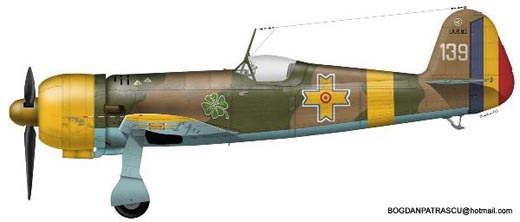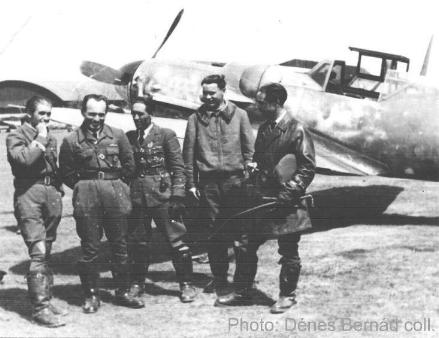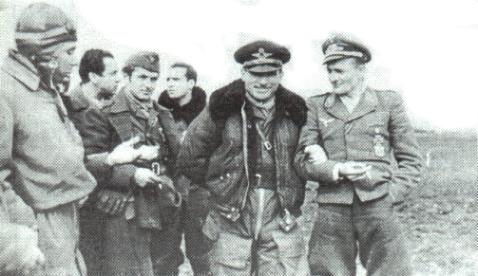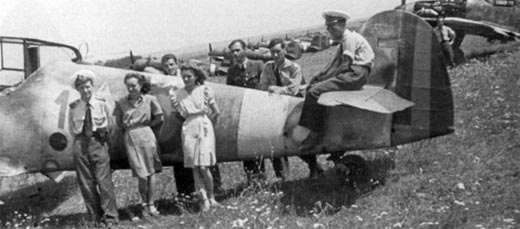|
The 9th Fighter Group was created on 19 April 1942 and was made up of the 47th and 48th
Fighter Squadron. Its first commander was lt. cdor. Gheorghe Borcescu. It was equipped with
IAR-80s and manned by the fresh 1941 promotion of fighter pilots. The group was based on
the Pipera airfield, near Bucharest. The 52nd Squadron was later attached to it until
August 1942.
In February 1943 the unit starts to train on the He-112B and in March it moves to
Tiraspol where it begins to convert to the new Bf-109Gs. In August, 10 of the group's
pilots are sent on the from to the 7th Fighter Group.

Profile courtesy of
Bogdan Patrascu
This IAR-80 belonged to serg. av. Casian Teodorescu from the 9th
Fighter Group in 1942
They returned to the 9th Fighter Group on 23 October, when it replaced the exhausted
7th Fighter Group. However, a part of the experienced aces of the 7th remained. The group
consisted of three squadrons: 47th, 48th and 56th, all equipped with the excellent Bf-109G,
and was commanded by lt. cdor. Gheorghe Georgescu.
The first victories came the same day, when the Romanian pilots shot down 6 airplanes.
Their successes continued the following days until 28 October, when cpt. Serbanescu shot
down a Yak, while protecting a Stuka formation. On 30 October the group was forced to move
to Kerson by Soviet tanks advancing towards the its airfield at Chaplinka.
November and December 1943, in the southern part of the Eastern Front weren't suitable
for intensive air activity. The Group totaled about 280 sorties in this period, but had only
11 dogfights and 2 confirmed victories. The group moved to Pervomaysk.
On 1 January 1944 lt. cdor. Gheorghe Stefanescu became the new commander of the unit.
Until 8 January the group was moved several times until it finally settled at Lepetika.
They started flying combat missions the next day. On 10, the group lost adj. stg. Constantin
Pomut, a seven victory ace of the 1941 campaign. Because the group started to make its
presence felt in the sector, the Soviets raided their airfield several times on 14 January.
Cpt. Serbanescu was returning from an escort mission and engaged the Yaks over Lepetika
airbase and shot down one of them. During another Soviet raid on 1 February, 10 of the
group's pilots scrambled and attacked the enemy formation and shot down 2 Il-2s and 2 Yaks.
On 9 February the group moved to Nikolaev and 4 days later, on 13, cpt. Alexandru
Serbanescu, one of the top ranking ARR aces with over 30 victories at that time, assumed
command of the 9th Fighter Group. His charisma and care for the good condition of the
troops quickly gained him the respect of his airmen. Under his leadership, the 9th Fighter
Group will reach the height of its effectiveness in the bloody summer of 1944.
During February 1944, the group executed 197 sorties, took part in 12 dogfights and
claimed 11 VVS aircraft. The first days of March weren't suitable for air activity. On
6 March they flew an armed reconnaissance mission over the front and the next day they
escorted a Hs-129 formation in a ground assault mission, which was badly needed by the
ground forces in the area around Novy Bug. The same thing the following days. So on 10
March the Soviet bombers and fighters pay another visit to the Nikolaev airfield. During
the attack, lt. Teodor Greceanu and adj. Tiberiu Vinca were returning from a mission. They
engaged the VVS aircraft shot down 3 of them, under the eyes of the Romanian Air Corps'
commander.
Because the Soviet ground forces had advanced to almost 15 km of Nikolaev the 9th Fighter
Group was moved to the Tatarka airfield, near Odessa. The weather wasn't very good for
operations, so the group used the time for rest and relaxation. 8 of its officers were
promoted (7 to lieutenant and one to captain) and this was a good opportunity for a
serious party.
However, they had to move again, in front of the Soviet advance. This time they were
stationed on Romanian soil, at Tecuci. April 1944 was a busy month for the 9th Fighter
Group. Their missions varied from bomber and assault aircraft escort, free-hunting missions
to airfield protection. One of the most important mission was the protection of marshal
Antonescu's Fi-156 Storch, during his inspections on the front. In total they flew 462
sorties, engaged in 20 dogfights and shot down 15 enemy aircraft.

Picture from Dénes Bernád's collection
Serbanescu, Milu and other 9th Fighter Group pilots on the Tecuci
airfield, 1944
May started with intense activity on the Moldavian front, because of the Soviet
offensive in the Targu-Frumos area. Lt. Vasile Gavriliu shot down 2 Soviet aircraft
during these operations and adj. Iosif Moraru got one.
This period was followed by a lull of about five days. The group
started to fly free-hunting and escort missions after this. The dogfights with the VVS
forces in the area were frequent and successful for the pilots of the 9th Fighter Group,
who shot down 15 aircraft by the end of the month. Six of these were claimed on 30 May.
On the first mission of the day, cpt Serbanescu led a Bf-109G patrulă (made out of
him, Feldwebel Ernest Stengel, cpt. Gheorghe Popescu-Ciocanel and adj. Constantin Miron)
in a fighter sweep north of Iasi (Jassy). They encountered 9 Soviet P-39s and attacked them.
Serbanescu missed his 41st kill, because of a malfunction that filled his windscreen with
oil. Barely seeing he managed to get out of the fight and return to the airfield. Cpt.
Gheorghe Popescu-Ciocanel also missed and soon was trying to evade a Soviet fighter, but his
wingman, adj. Miron intervened and shot the pursuer down. Soon some Yak-9s and Il-2s
joined the battle. Finally, cpt. Popescu managed to shoot down one of the Soviet fighters
in the area. Later that day, Serbanescu took off together with of. echip. cl. III Ion
Milu and adj. Ion Mucenica on a Ju-88 escort mission. These were attacked by 6 P-39s. The
Romanian fighters engaged them and Ion Milu scored his 31st victory. Another one was downed
by Ion Mucenica. The other two victories belonged to lt. Ion Dobran and adj. Cristea
Chirvasauta and were scored during the numerous Hs-129 escort missions of the day.
The group was joined by the other major Romanian ace: cpt. Constantin Cantacuzino, just
in time to strengthen it for the up-coming battles with the USAAF. They were only allowed
to intercept the Americans that were flying in their sector towards airbases in the Soviet
Union. The first mission against them was flown on 6 June. Cpt. Serbanescu took off with
14 airplanes to meet the bomber formations. The dogfights were confusing, but the group
scored one confirmed and one probable victory. The confirmed Mustang belonged to cpt.
Cantacuzino and the probable Mustang to lt. Dorbran. Lt. av. Dobran was playing bridge with
Mucenica, Senchea and Simionescu, when the alarm was given. They took off quickly and
because of this rush, he ended up without a wingman. He saw the USAAF formation and then
he realized that he was alone. Below him were four monoplanes and first thought they were
"Gustavs" from 56th Squadron. When he got closer he recognized the Mustangs. They were
flying like they were at a parade. Dobran dove and fired at the one on the right. Smoke
started to come out of the airplane. The others dispersed. He went for the bombers, but
he fired from distance, because the Mustangs were closing in. He plunged down and managed
to shake off two of them after some acrobatic flying. But the one that remained shot him
down.
The missions alternated between sorties against the VVS and sorties against the USAAF.
On 19 June, when the Luftflotte IV devised the "Sternflug" plan to counter the American
attacks. When the enemy formations were detected on radar, the 6 German fighter groups and
the 7th and 9th Romanian Fighter Groups (Bf-109G) were all assembled and directed against
the attacking force. The Fw-190s were suppose to engage the bombers, while the Bf-109Gs
protected them from American fighters. The plan was good in theory, but it did not work
very well in practice. One such occasions was on 24 June, when 20 of the group's Bf-109Gs
were sent to engage the USAAF aircraft. They stumbled upon a formation of 13 Liberators.
In the following attack, three B-24s were shot down.
In June 1944, the 9th Fighter Group flew 232 sorties and scored 10 victories. In the
dogfights with the much superior (in numbers and performance of their airplanes) USAAF, the
group lost adj. Constantin Lungulescu (12 victories) and lt. Teodor Greceanu (20 victories)
and adj. Dumitru Encioiu (5 victories) were wounded.
As losses grew in July, the morale of the men of the 9th Fighter Group, which until then
was very high, started to decrease. During this month the group flew 239 sorties and scored
28 victories in 12 dogfights. The day of 26 July 1944 remained in the group's history as
"the Black Day". 18 Gustavs from the 9th Fighter Group took off to engage a formation of
20 unescorted bombers, as the radar station reported. In fact there were more bombers,
which were protected by over 100 P-38s and P-51s. At about 2500 m they spotted a formation
of Lightnings. Lt. Dobran, adj. Malacescu and adj. Mucenica attacked them, The first two
missed because of their high speed, but Mucenica maneuvered carefully and shot one American
down. Dobran got separated from his colleagues. He managed to get behind a P-38 and downed
it. Then, with 8 Lightnings on his tail he tried to escape, but he was hit in the engine
and had to make a belly-landing. Adj. Moraru also got separated from his wing commander, but
met up with adj. Darjan and managed to return home, after each had shot down a P-38. Adj.
Nicoara and cpt. Popescu-Ciocanel also got one each. Lt. Mircea Senchea, after loosing
Moraru, found a lone P-38, surprised it and sent it down in flames. All of this lasted only
30 minutes. The Romanian pilots scored 11 victories, but the price was very high: 7
airplanes, four dead pilots and two wounded. Serbanescu and Cantacuzino were away at
Bucharest at a meeting with air force brass, so the formation was led by cpt. Gheorghe
Popescu-Ciocanel, who was severely wounded and died a few days later (on 12 August). On 31
July, the group lost lt. Dinu Pistol.

Picture from "Rumanian Air Force, the prime decade 1938-1947" by
Dénes Bernád, Squadron/Signal Publications, 1999
Serbanescu with the Luftwaffe liaison officer, lt. Ludwig Neuböck,
and other 9th Fighter Group pilots
At the beginning of August the unit was moved to the Buzau airfield and put under the
direct command of the 2nd Fighter Sector. On 4 August cpt. Serbanescu led 16 Bf-109Gs into
combat against the USAAF formations. During this dogfight he claimed a P-51, while the other
ace, cpt. Constantin Cantacuzino, claimed two P-38s. On 8 August it was cpt. Cantacuzino's
time to lead 18 airplanes in the last successful combat with the 15th Air Force. Of. echip.
cl. III Ion Milu shot down a P-38, only to be shot down himself and wounded after that.
Another two Mustangs were claimed, but the group also lost adj. Encioiu who had to bail out
of his damaged airplane and was wounded. Two days later adj. Ion Panait was killed in
action. Out of the once mighty 9th Fighter Group, only 13 pilots remained.
The most sad day of the 9th Fighter Group and of the ARR was 18 August. Serbanescu took
off with 13 Bf-109Gs. They engaged a much larger formation of Mustangs. During the
dogfight, the ace maneuvered quickly and left his wingmen a lot behind him. A Mustang got
on his tail. Adj. Traian Dârjan told Serbanescu to watch out, but he did nothing. The
American fired and "Yellow 1" Bf-109 G went to the ground. He communicated that day only
with the ground control. Probably his radio was malfunctioning and he didn't hear his
wingmen. This was the last American raid over Romania (there was another one after 23
August 1944, but in support of Romanian troops fighting the Germans). Serbanescu's death
also marked the moral defeat of ARR.
The new commander of the 9th Fighter Group was cpt. Constantin "Bâzu" Cantacuzino.
There was no time to mourn Serbanescu, as the Red Army launched the Iasi-Chisinau (Jassy-
Kishinev) offensive on 20 August. By 22 August, the group already claimed 9 VVS aircraft
shot down, but this did not change the overall picture. On 23 August, Romania sued for
peace and all military actions against the Allies ceased.
The Germans were not going to take this easily and decided to reinstall a pro-Axis
government at Bucharest and fights erupted between German and Romanian forces. The 9th
Fighter Group was moved on the Popesti-Leordeni airfield near the capital, in order to
bolster air defenses around it. In the morning of 25 August, cpt. Cantacuzino with other
6 Bf-109Gs intercepted 11 He-111s which were going to bomb the city. Three were shot down
and another three damaged. After this they attacked a Stuka formation and shot down one
of them. The next day, they claimed another 3 German airplanes and destroyed another two
Ju-52s on the ground.
Until 31 August, the 9th Fighter Group flew 41 sorties and claimed 7 confirmed victories,
3 probable and two on the ground. After this the 7th Fighter Group was disbanded and its
forces were united with the 9th. The new unit was named the 7/9th Fighter Group for a
while. It was again remained the 9th Fighter Group. The new commander was cpt. Lucian Toma.
The group was dispatched to the Turnisor airfield in southern Transylvania for the new
campaign against the Axis. They immediately started to fly escort missions for the
bombers and assault aircraft that were attacking the German and Hungarian forces on the
ground. They even carried out some ground attack missions themselves.
On 15 September they performed a low-level attack on the Someseni airfield near Cluj.
They came in from the north and achieved complete surprise. They destroyed a Re-2000, a
Fw-58 and three transport gliders. The same day they had to move to the Balomir airfield.
The first clash with the Luftwaffe Bf-109Gs took place on 18 September, when the group
lost one airplane and another crash landed.
There other engagements the next days as the Romanian-Soviet offensive progressed.
The Romanian Bf-109Gs managed to protect their bombers. On 25 September, cpt. Lucian
Toma shot down a Ju-188, but was himself hit by the gunners and went down with it. The
command was again assumed by cpt. Constantin Cantacuzino.
During September 1944, the group flew 314 sorties and October started with the usual
combat missions. The weather didn't allow very much activity during late autumn and winter
of 1944, but every effort was made to help the ground troops in need of assistance. The
Luftwaffe wasn't a very common sight in this period, because of the little importance
given to this part of the front. The group moved from airfield to airfield in Transylvania
as the offensive progressed and then passed into present-day Hungary and settled for the
winter at Miskolc on 14 December. In February 1945 it moved to Lucenec in Slovakia.
On 25 February 1945, the last major ARR offensive of the war was launched. It was aimed
at supporting the ground forces which were attacking in the Zvolen area (in Slovakia). On
his fifth mission that day, cpt. Cantacuzino took off with adj. Traian Dârjan as his
wingman. They encountered 8 Fw-190Fs which were attacking Soviet troops and engaged them.
The captain, ARR's top scoring ace of the war, shot down one of them and the others fled.
In order to validate the kill, the two Romanian pilots got careless and started to look
for the wreck. They failed to see the approaching Rotte of German Bf-109Gs, lead by hptm.
Helmut Lipfert, Kommandeur of I./JG 53. Adj. Traian Dârjan fell victim to the Luftwaffe
ace, his former instructor at Tiraspol. A 13 mm bullet almost beheaded him. He crashed
near the Romanian lines. Cpt. Cantacuzino didn't even notice that his wingman was in
trouble. He was also surprised by Lipfert's comrade and shot down. He escaped and returned
to the 9th Fighter Group's base with a car from a Romanian division. He told what happened
and concluded: "Adj. Dârjan must be dead." The second kill of the day and also the last
victory achieved by an ARR fighter during WWII, belonged to adj. Constantin Nicoara who
shot down a Bf-109K in an engagement with four Luftwaffe Messerschmitts. In the same
dogfight, two Romanian Bf-109s were damaged.
As the weather improved, the number of missions increased. Only in the first three days
of April, the group flew 69 sorties and the following days they had an average of 14-21.
There were no more encounters with Luftwaffe forces. In many of the missions the fighters
carried out low-level attacks against ground targets. On 7 April they moved to Zvolen and,
on 13 April, to Bodin. In April the 9th Fighter Group flew a total of 225 sorties.

Picture from "Rumanian Air Force, the prime decade 1938-1947" by
Dénes Bernád, Squadron/Signal Publications, 1999
lt. Ion Galea with his Hungarian fiancee and her sister and
lt. Teodor Greceanu (on the stabilizer), at Miskolc, July 1945
6 May was the second Easter on the front for 9th Fighter Group. The second day the
Prague Operation started and a few escort missions followed. On 9 May the fighters
protected IAR-39s that were observing the German troops in the area and dropping leaflets.
The last mission of the war for the 9th Fighter Group was flown on 11 May, however. Four
Bf-109Gs escorted Romanian bombers against remnants of the Vlasov Army, which were
refusing to capitulate. |